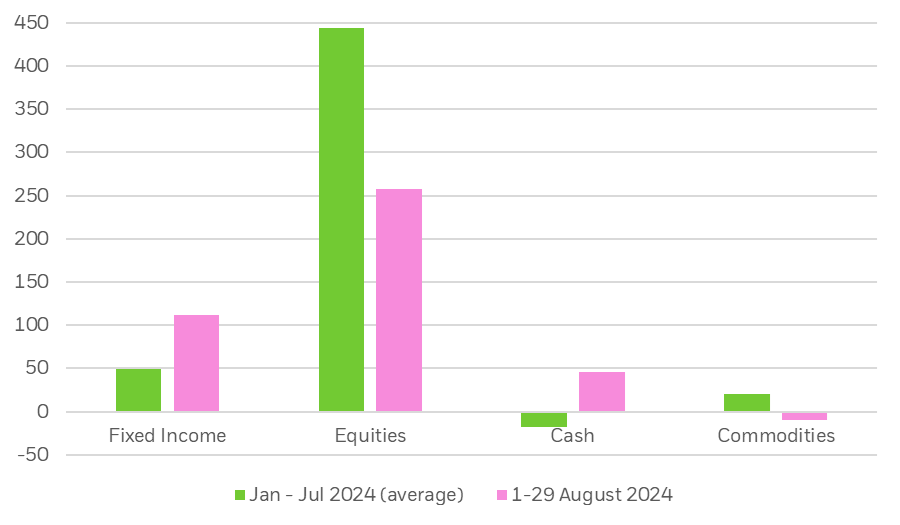
Why long duration bonds matter to your portfolio
As investors anxiously await the first rate cut from the Federal Reserve, long duration bonds are soaring in popularity, with iShares’ long-dated Treasury exposure now one of the largest bond ETFs in the world.* Hui Sien Koay, Head of iShares Fixed Income Product Strategy, APAC ex-Japan, explains what’s driving this growth and how long-end bond ETFs can help to build an efficiently diversified portfolio.
Key takeaways
- Global inflows to long-duration US Treasury bond ETFs are soaring, as investors expect strong performance in the lead-up to US rate cuts and look for a hedge against further equity market volatility.
- The negative correlation between bonds and equities has returned, so they are expected to provide solid diversification benefits in a multi-asset portfolio.
- Long-dated government bonds can allow investors to get ‘more diversification for less’, meaning they can get exposure to bond markets without having to move as much money out of cash.
Investors jump into long-end bond ETFs
August 2024 was a volatile month for equity markets, but a lucrative one for bonds. In the US, iShares’ 20+ Year Treasury bond exposure saw one of the biggest months for inflows since its inception in 2002, with almost US$4.4 billion flowing into the fund in the month of August.1
This fund is the third biggest bond ETF in the world and consistently gathers large flows, with year to date inflow of over US$11 billion. But since soft US jobs data sent markets into a recession panic, and Federal Reserve chair Jerome Powell signalled interest rate cuts were coming at last month’s Jackson Hole meeting, investors are anticipating particularly strong performance in long duration bonds as the US yield curve comes down.
A key point to note is that falling rates will typically push prices for bonds at the longer end proportionately higher. For instance, if the Federal Reserve were to cut rates by 1%, you may theoretically see about 5% price growth in a Treasury bond fund with 5 years duration, and about 20% price growth in a Treasury bond fund with 20 years duration.
The rise in value of longer-dated bonds is one of the reasons you may see spiking flows in these exposures in the lead-up to a rate cut. In the chart below, you can see the movement of the ICE US Treasury 20+ Year Bond Index (AUD Hedged) (tracked by our newest Australian ETF, ULTB) when US interest rates last fell during the COVID pandemic.

Source: Bloomberg data as of 19 August 2024.
If we look at the index’s recent performance, we can see it jumped around 3% during the market downturn on 5 August, and has stayed about 1% above its value at the beginning of August. In the past three months, as expectations around a rate cut in the US have mounted, the index value has increased about 6%.2
For more detail on why bonds tend to outperform when rates are ‘on hold’, and why now may be the time to consider adding duration into your portfolio, you can read our full white paper, No Time to Yield.
Why bonds are back in vogue
Bonds have traditionally been an important portfolio diversifier for investors as they tend to move in the opposite direction to equity markets from a price perspective, and therefore can provide a useful ‘cushion’ against market selloffs. Less volatility than equities and guaranteed income have also typically been attractive features for investors when it comes to bonds.
However, in the low rate environment that characterised the years before and during the COVID pandemic, the income offered by bonds all but disappeared, lessening their appeal for investors. In 2022, the typical inverse correlation between stocks and bonds broke due to the unique economic environment of rising inflation and aggressive interest rate hikes by central banks.
As Chair Powell said at the Fed’s Jackson Hole meeting in August, the US central bank “do not seek or welcome further cooling in labor markets” and there is “ample room to respond to any risks we may face”. With interest rate cuts on the horizon in the US, we believe that negative correlation has returned to the bond market.
While there are many drivers of markets, especially when geopolitical and election risks abound, the start of the rate cut cycle - especially when not accompanied by a recession - can be a good time to be invested in equities and bonds.
This may go some way to explaining why we have seen such an abrupt shift into fixed income as nerves around the US economy grew in August – across iShares’ Australian fixed income ETF range, inflows topped $110 million from 1-29 August, more than double the monthly average of $44 million for the year to July 2024, as you can see in the chart below.
iShares Australian ETF flows by product category ($m)

Source: BlackRock data as of 30 August 2024. Past performance is not a reliable indicator of future performance. Index performance returns do not reflect any management fees, transaction costs or expenses. Indexes are unmanaged and one cannot invest directly in an index.
Adding duration – different ways to trade
It is not surprising that cash products are still in favour per the chart above, with US short term rates and Australian cash term deposits still offering yields of almost 5% in some instances. This is because investors have been unconvinced that the term premium in holding long-end bonds – which are currently yielding around 4-4.5% - is adequate.
However, as the US Fed is all but guaranteed to join European Central Bank, the Bank of England and others in cutting rates this September 2024, such attractive rates will fall swiftly. How can investors position their portfolios against this backdrop?
iShares offers a wide range of cash and fixed interest ETFs designed to meet different investor needs and market conditions. Our latest addition, the iShares 20+ Year US Treasury Bond AUD Hedged ETF (ULTB), can provide an efficient option for those who might be unwilling to give up their cash yields until interest rate cuts materialise.
If we imagine an investor with $1000 in a cash account yielding 5%, they could invest $200 in ULTB, which currently has a modified duration of 16 years, to achieve an overall portfolio duration of 3+ years.
Or, they could switch $500 into an intermediate-duration fund – such as the iShares Global Aggregate Bond ESG (AUD Hedged) ETF or iShares Government Inflation ETF -which carries less volatility risk and offers similar diversification benefits, to also target a 3-year overall portfolio duration.
Depending on the investor’s preference, both could be compelling ways to add duration - the key difference being that the ULTB investor will have more money still earning the 5% yield from cash.
While the timing of a rate cut from the RBA is not as immediate as in the US, investors can consider the iShares 15+ Year Australian Government Bond ETF (ALTB) alongside the iShares Core Cash ETF (BILL) or iShares Enhanced Cash ETF (ISEC) ahead of a move in the Australian interest rate. As we discussed in the above-mentioned white paper, the market has shown its tendency to price in changes to official cash rates well before they occur.
This may not be the right solution for every client as there are many factors to consider, particularly volatility. But as the dynamics in markets begin to change – both in terms of falling interest rates and increasing volatility in equities – adding some duration and defensive positioning may be worth investor consideration.

